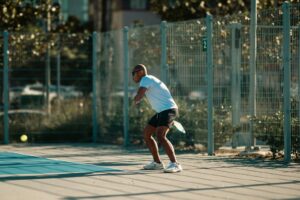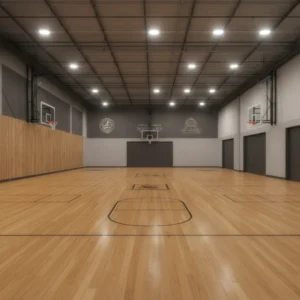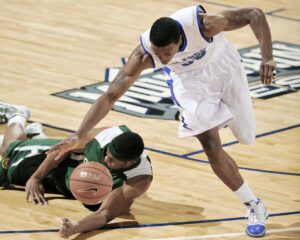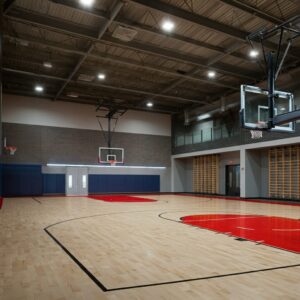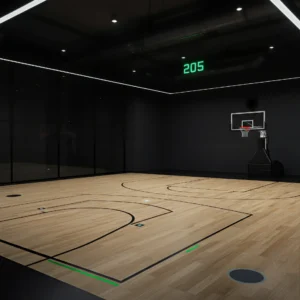When constructing or renovating a basketball facility, one of the most critical decisions you’ll make involves the basketball wood floor thickness. This seemingly technical detail can make or break the performance, safety, and longevity of your court. Whether you’re an athletic director planning a new gymnasium or a contractor specializing in sports flooring installation, understanding the precise thickness requirements ensures optimal playing conditions and regulatory compliance.
The thickness of your basketball court floor directly impacts everything from player safety to ball bounce consistency. Too thin, and you risk compromised performance and increased injury rates. Too thick, and you may exceed building height restrictions while inflating costs unnecessarily. Professional sports organizations, educational institutions, and recreational facilities all depend on precise wood floor standards to deliver exceptional playing experiences.
Getting the basketball floor thickness right the first time saves thousands in potential retrofitting costs while ensuring your facility meets professional sports flooring standards. Let’s explore the exact specifications, installation considerations, and maintenance requirements that will help you make the best decision for your basketball court project.
Why Basketball Floor Thickness Matters
Player Safety and Injury Prevention
Basketball floor thickness serves as the foundation for player safety on the court. Properly specified wood court installation provides the essential shock absorption needed to protect athletes during high-impact movements. When players jump, pivot, and sprint across the court, the floor must absorb and distribute these forces effectively.
Insufficient thickness compromises the floor’s ability to flex appropriately, leading to jarring impacts that can cause knee, ankle, and back injuries. Professional sports flooring guidelines emphasize that adequate thickness creates a “responsive” surface that gives slightly under pressure while maintaining structural integrity.
Performance Consistency and Ball Bounce
The thickness of your basketball wood floor directly affects ball bounce consistency across the entire court surface. Sports flooring standards require uniform ball rebound characteristics, which depends heavily on consistent subfloor support and proper wood thickness throughout the installation.
A court with varying thickness levels creates dead spots where the ball bounces unpredictably, frustrating players and compromising game quality. Professional basketball courts maintain strict bounce specifications, with the ball returning between 49-56 inches when dropped from 72 inches.
Structural Longevity and Investment Protection
Proper basketball court thickness ensures your flooring investment delivers decades of reliable performance. Adequate thickness provides the structural stability needed to withstand constant use, cleaning, and refinishing cycles without warping or developing structural weaknesses.
Facilities that skimp on thickness often face premature replacement costs, disrupted schedules, and safety concerns. Quality wood court standards protect your investment while minimizing long-term maintenance expenses.
Industry Standards for Basketball Wood Floor Thickness
FIBA and Professional League Requirements
International basketball governing bodies establish specific sports flooring guidelines for competitive play. The Federation Internationale de Basketball (FIBA) requires basketball wood floors to meet strict thickness specifications that ensure consistent performance across global competitions.
Professional leagues mandate basketball floor thickness of 25mm (approximately 1 inch) for the wood surface layer, supported by appropriate subfloor systems. This standard ensures optimal ball bounce, player safety, and surface durability under intensive use conditions.
NCAA and High School Standards
Educational institutions follow sports flooring standards that balance performance requirements with budget considerations. The National Collegiate Athletic Association (NCAA) recommends basketball court thickness specifications that provide professional-level performance while accommodating various facility constraints.
High school gymnasiums typically utilize wood floor standards that meet safety requirements while managing installation costs. The minimum recommended thickness for educational facilities is 22mm (7/8 inch) for the hardwood surface, with proper subfloor support systems.
Recreational and Community Standards
Community centers and recreational facilities can utilize slightly modified basketball floor thickness requirements while maintaining safety and performance standards. These facilities often balance cost considerations with performance needs, utilizing sports flooring installation techniques that provide excellent value.
Recreational courts benefit from wood court standards that emphasize durability and low maintenance while delivering consistent playing characteristics. The recommended thickness for recreational facilities ranges from 20-25mm depending on usage intensity and budget parameters.
Types of Wood Flooring and Their Typical Thicknesses
Solid Hardwood Systems
Traditional solid hardwood basketball courts utilize single-piece wood planks with consistent thickness throughout the installation. These systems typically feature 25mm (1 inch) thick maple planks that provide exceptional durability and performance characteristics.
Solid hardwood offers superior refinishing capabilities, allowing facilities to maintain optimal playing surfaces for decades. The consistent wood court installation thickness ensures uniform performance across the entire court surface.
Engineered Wood Systems
Modern engineered basketball wood floors combine hardwood playing surfaces with engineered core materials. These systems often utilize 20-22mm total thickness while maintaining professional performance standards through advanced construction techniques.
Engineered systems offer enhanced stability and moisture resistance compared to solid wood alternatives. The sports flooring guidelines for engineered systems emphasize proper subfloor preparation and installation techniques to maximize performance benefits.
Specialized Biomass Systems
Innovative biomass sport wooden floor systems like COPOSPORTS products utilize sustainable materials while delivering professional-grade performance. These systems often feature optimized thickness specifications that balance environmental responsibility with athletic performance requirements.
Biomass basketball floors provide excellent shock absorption and ball bounce characteristics while meeting strict environmental standards. The hardwood sport court floor systems deliver professional performance with reduced environmental impact.
Installation Considerations for Optimal Performance
Subfloor Preparation Requirements
Proper sports flooring installation begins with meticulous subfloor preparation. The subfloor must be level, dry, and structurally sound to support the basketball wood floor effectively. Any irregularities in the subfloor can compromise the floor’s performance and longevity.
Professional installation teams utilize precision measuring equipment to ensure subfloor flatness within 1/8 inch over 10 feet. This level of precision ensures consistent basketball floor thickness across the entire court surface.
Moisture Management Systems
Effective moisture control is essential for maintaining proper basketball court thickness over time. Wood floors expand and contract with humidity changes, potentially affecting thickness uniformity and performance characteristics.
Installation teams implement comprehensive moisture barriers and climate control systems to maintain stable conditions. These systems protect the wood court installation investment while ensuring consistent performance year-round.
Expansion Joint Considerations
Professional sports flooring installation includes carefully planned expansion joints that accommodate natural wood movement without compromising thickness uniformity. These joints allow the floor to expand and contract while maintaining structural integrity.
Properly designed expansion systems ensure that basketball floor thickness remains consistent across seasonal changes and varying usage patterns. This attention to detail protects both performance and investment value.
Maintenance and Longevity Factors
Routine Care Protocols
Maintaining optimal basketball wood floor thickness requires consistent care protocols that protect the surface while preserving structural integrity. Daily cleaning, regular inspection, and prompt repair of minor issues prevent major problems that could compromise thickness uniformity.
Professional maintenance teams utilize specialized equipment and techniques designed specifically for sports flooring. These protocols ensure that the hardwood sport court floor maintains its performance characteristics throughout its service life.
Refinishing and Restoration
Regular refinishing cycles help maintain the basketball court thickness while refreshing the playing surface. Professional refinishing involves precise material removal and application techniques that preserve the original thickness specifications.
Quality wood floor standards recommend refinishing every 3-5 years for heavily used facilities, with careful attention to maintaining uniform thickness across the court surface. This proactive approach maximizes the floor’s service life while ensuring consistent performance.
Environmental Control
Maintaining stable environmental conditions protects basketball floor thickness from moisture-related expansion and contraction. Professional facilities utilize sophisticated HVAC systems designed specifically for sports flooring applications.
These systems maintain optimal temperature and humidity levels that preserve the wood court installation integrity while ensuring player comfort and safety. Proper environmental control is essential for maximizing floor performance and longevity.
Case Studies: Thickness Performance Outcomes
Professional Arena Success Story
A major professional basketball arena recently upgraded to COPOSPORTS biomass sport wooden floor with optimized thickness specifications. The installation utilized 25mm hardwood surfaces with advanced subfloor systems, delivering exceptional performance outcomes.
The facility reported improved player satisfaction, consistent ball bounce characteristics, and reduced maintenance requirements. The basketball wood floor thickness specifications met all professional league requirements while providing enhanced durability and performance.
Educational Institution Project
A university gymnasium renovation project demonstrated the importance of proper sports flooring guidelines in educational settings. The facility upgraded from an outdated court to a modern system with precise thickness specifications.
The new basketball court thickness provided improved safety characteristics, reduced injury rates, and enhanced playing experience for student athletes. The installation met NCAA standards while staying within budget constraints.
Community Recreation Center
A community center installation showcased how proper wood court standards can deliver professional performance in recreational settings. The facility balanced cost considerations with performance requirements through careful thickness specification.
The outdoor basketball court floor installation provided excellent durability and performance while meeting budget constraints. The project demonstrated that proper sports flooring installation techniques can deliver exceptional value in community applications.

Frequently Asked Questions
What is the minimum thickness for a basketball wood floor?
The minimum basketball floor thickness for competitive play is 20mm (3/4 inch), though professional standards typically require 25mm (1 inch). The exact thickness depends on your facility’s usage level, governing body requirements, and performance expectations.
How does floor thickness affect ball bounce?
Basketball court thickness directly impacts ball bounce consistency through structural rigidity and shock absorption. Proper thickness ensures uniform bounce characteristics across the entire court surface, meeting professional sports flooring standards.
Can I install a basketball floor over existing flooring?
Installing basketball wood floors over existing surfaces requires careful evaluation of total thickness, structural support, and height restrictions. Professional sports flooring installation teams can assess your specific situation and recommend appropriate solutions.
What thickness is required for outdoor basketball courts?
Outdoor basketball court floors require enhanced thickness specifications to withstand weather exposure and temperature variations. These installations typically utilize specialized materials and construction techniques designed for exterior applications.
How often should I measure floor thickness?
Regular thickness monitoring during routine maintenance helps identify potential issues before they compromise performance. Professional facilities typically check thickness uniformity during annual inspections and refinishing cycles.
Does floor thickness affect installation costs?
Basketball floor thickness directly impacts material costs, but the investment pays dividends through improved performance, safety, and longevity. Proper thickness specifications reduce long-term maintenance costs while ensuring regulatory compliance.
Investing in Professional Standards Pays Dividends
Understanding basketball wood floor thickness requirements empowers you to make informed decisions that balance performance, safety, and budget considerations. Professional sports flooring standards exist to protect athletes while ensuring consistent playing experiences across all facilities.
The investment in proper basketball court thickness pays dividends through reduced injury rates, improved performance, and extended floor life. Whether you’re installing a professional arena or community recreation center, adhering to established wood floor standards ensures optimal outcomes.
COPOSPORTS biomass sport wooden floor systems deliver professional-grade performance while meeting strict environmental standards. Our hardwood sport court floor solutions provide the precise thickness specifications needed for exceptional athletic performance.
Ready to upgrade your basketball facility with professional-grade flooring that meets all thickness requirements? Contact us for expert installation guidance and discover how proper sports flooring installation can transform your athletic facility into a world-class venue.


